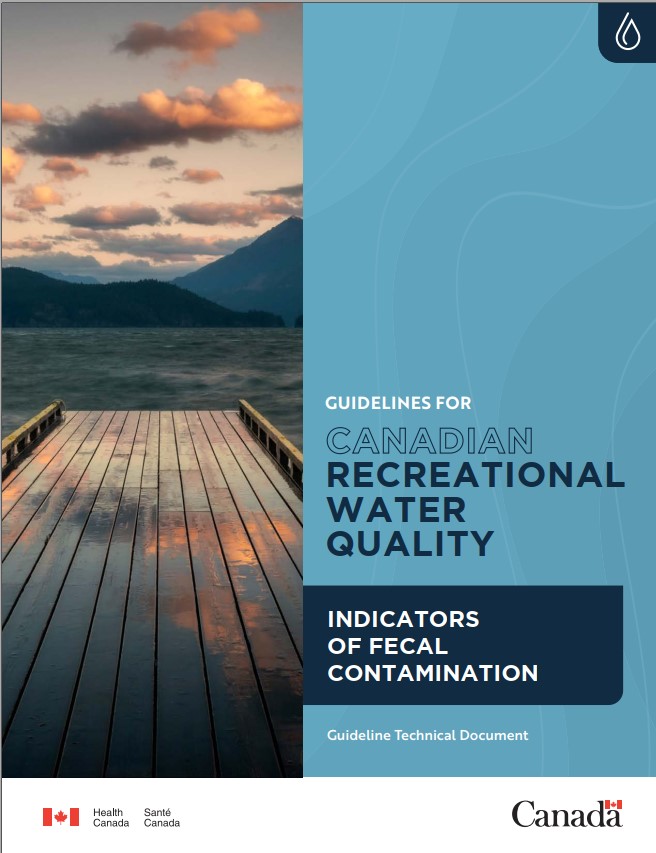Canadian recreational water quality guidelines - Indicators of fecal contamination: Overview
On this page
Foreword
The Guidelines for Canadian Recreational Water Quality are comprised of multiple guideline technical documents that consider the various factors that could interfere with the safety of recreational waters from a human health perspective. This includes technical documents on understanding and managing risks in recreational waters, indicators of fecal contamination, microbiological sampling and analysis, cyanobacteria and their toxins, physical, aesthetic and chemical characteristics, and microbiological pathogens and other biological hazards. These documents provide guideline values for specific parameters used to monitor water quality hazards and recommend science-based monitoring and risk management strategies.
Recreational waters are any natural fresh, marine or estuarine bodies of water used for recreational purposes; this includes lakes, rivers and human-made systems (for example, stormwater ponds, artificial lakes) that are filled with untreated natural waters. Jurisdictions may choose to apply these guidelines to other natural waters for which limited treatment is applied (for example, short-term use of disinfection for an athletic event). Applying the guidelines in these scenarios should be done with caution. Some disease-causing microorganisms (for example, protozoan pathogens) are more difficult to disinfect than fecal indicator organisms and may still be present even if disinfection has reduced the fecal indicators to acceptable levels.
Recreational activities that could present a human health risk through intentional or incidental immersion and ingestion include primary contact activities (for example, swimming, wading, windsurfing and waterskiing) and secondary contact activities (for example, canoeing, boating or fishing).
Each guideline technical document has been established based on current, published scientific research related to health effects, aesthetic effects and beach management considerations. The responsibility for recreational water quality generally falls under provincial and territorial jurisdiction, therefore the policies and approaches, as well as the resulting management decisions, may vary between jurisdictions. The guideline technical documents are intended to guide decisions by provincial, territorial, and local authorities that are responsible for the management of recreational waters.
This document focuses on the indicators of fecal contamination. For a complete list of the guideline technical documents available, please refer to the Guidelines for Canadian Recreational Water Quality summary document available on the Canada.ca website (in publication). For issues related to drinking water, please consult the Guidelines for Canadian Drinking Water Quality – Guideline Technical Document on Escherichia coli (Health Canada, 2020b) and Guidance on the use of Enterococci as an Indicator in Canadian Drinking Water Supplies (Health Canada, 2020a).
Using indicators of fecal contamination for recreational water quality management
This document outlines how indicators of fecal contamination can be used as one component of a preventive risk management approach alongside other activities, such as environmental health and safety surveys (EHSS) and, in some cases, microbial source tracking (MST) investigations. Recreational waters may be impacted by fecal material containing enteric pathogens from numerous sources, including discharged sewage, treated wastewater effluent, stormwater runoff from agricultural or urban areas, industrial processes, wild or domesticated animals and even fecal shedding by swimmers. The degree of risk from enteric pathogens varies between sources of fecal contamination, with sewage sources generally considered the most significant (in terms of the highest concentrations of infectious enteric viruses, bacteria and parasitic protozoa). Routine testing of recreational waters for pathogens is generally impractical, due to the variability in the types and quantities of pathogens present at any one time and the degree of difficulty associated with many of the detection methods. Consequently, as part of a risk management approach for recreational waters, authorities monitor for fecal indicators that are present in high numbers in both human and animal feces. Elevated numbers of these indicators in the aquatic environment are used to indicate fecal contamination and an elevated risk of illness.
Guideline values have been developed for Escherichia coli (E. coli) and enterococci. The values consider both the potential health risks associated with recreational activities and the benefits of recreational water use in terms of physical activity and enjoyment. These guideline values are considered to represent an acceptable level of risk for recreational activities for the general public.
E. coli and enterococci are recommended as primary indicators of possible fecal contamination and of potentially elevated gastrointestinal illness (GI) risk in recreational waters impacted by human enteric pathogens. Quantitative microbial risk assessment studies have shown that, similar to waters contaminated with human sewage, waters impacted by ruminants (for example, cattle feces) may also present a significant risk to human health. Recreational areas that are not impacted by human or ruminant fecal sources generally contain lower levels of human pathogens, compared to those impacted by human and ruminant feces, at similar levels of E. coli and enterococci. Detection of E. coli and enterococci at the guideline levels, in water sources that are not impacted by human and ruminant feces, may therefore represent a lower level of risk to human health. Alternative water quality criteria may be developed for these potentially lower risk recreational waters on a site-specific basis. However, care is needed to ensure that the risk of illness associated with any new criteria does not exceed the acceptable level of risk. Recreational area managers are encouraged to determine the sources of fecal contamination impacting a recreational water site. A variety of options are available, such as EHSS and MST methods, as well as alternative indicators, to determine the sources of contamination and the remediation priorities to improve the water quality for recreators.
More details on risk management of recreational water quality are available in the Guidelines for Canadian Recreational Water Quality – Guideline Technical Document on Understanding and Managing Risks in Recreational Waters technical document (Health Canada, 2023).
Page details
- Date modified:
